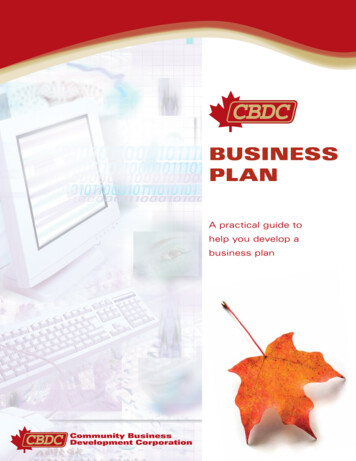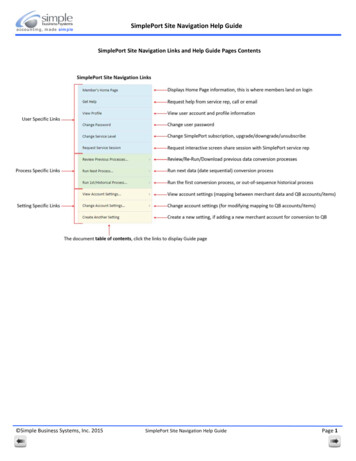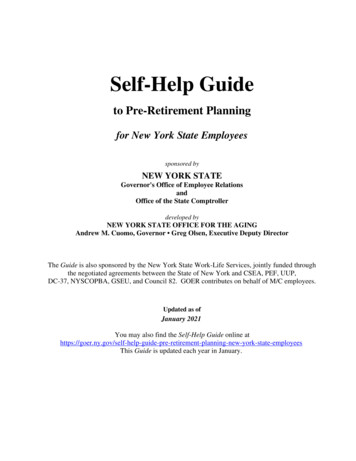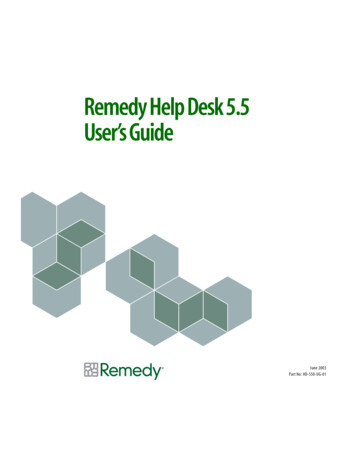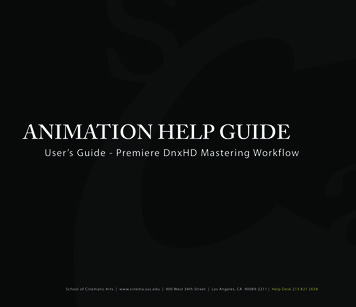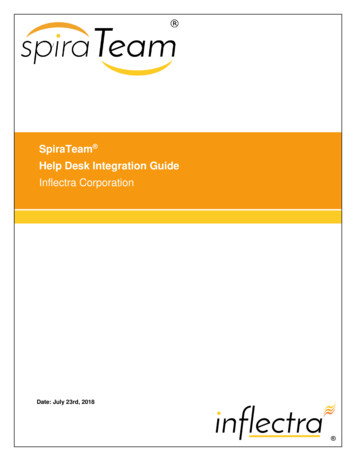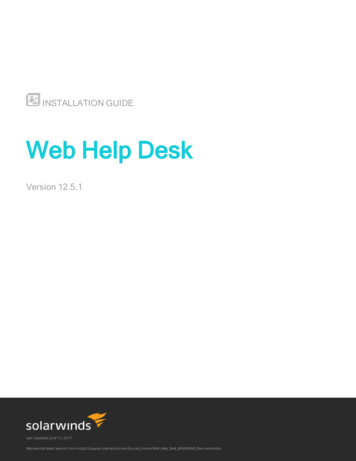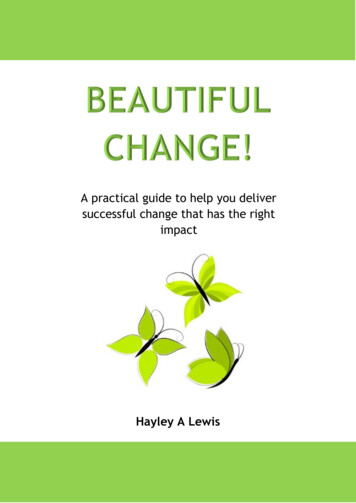
Transcription
A practical guide to help you deliversuccessful change that has the rightimpactHayley A Lewis
ContentsPreface .410 things this e-book will help you with .51. Getting started6Build the right team around you 6What’s your role? .8What kind of change are you implementing? .8Linear steps or emergent change? .9Why change fails 10The key ingredients for successful change .12Key points from chapter one .132. Know where you’re heading the importance of mission,vision and strategy16Mission and vision and strategy oh my! .16What do we really mean by strategy? .17The levers of organisational change .18Prioritising what (not) to do .19Developing the business case for change 20Key points from chapter two .213. Know how you’re going to get there the importance ofplanning and co-ordinating activity22Getting the right balance .22Force field analysis .23The process decision program approach (PDPA) .24Planning for every (well nearly) eventuality 26Key points from chapter three .284. Get buy-in the importance of identifying and managingstakeholders29The difference wants and needs of well everyone 29Stakeholder mapping .30Mapping by power and interest .32Stakeholders: Power, politics and change .34Key points from chapter four 351
5. Communicate and engage the importance of informingand involving people37Employee engagement 101 .37Five approaches that work .38Characteristics of effective engagement .41A step-by-step approach to building your strategy .41Key points from chapter five .436. Find your way through the fog managing the transitionfrom old to new44Managing transition, in a nutshell .44Why managing transition is so important 46Baby steps and quick wins .49Key points from chapter six .517. Resistance to change the signs to spot and how tomanage52The psychological contract .52Cognitive dissonance .53Understanding where people are on the change curve .54Reinforce, don’t punish 57Key points from chapter seven .598. Develop your people the importance of supporting andinvesting in staff60Before the change is launched 61During the change .61After the change .63Don’t forget yourself! .64Key points from chapter eight .65Final thoughts 66References and suggested reading 67Appendix 1: Business case template . 69Appendix 2: Checklist of different communication and engagementpreferences .Appendix 3: Simple template for a communication and engagementstrategy .70712
List of illustrations, tools and tablesTable 1: Suggested competencies for change practitioners .7Table 2: Change leaders versus change managers (Kouzes & Posner) . 8Sketchnote summary: Leading change by John Kotter .14Sketchnote summary: 10 commandments for executing change byRosabeth Moss Kanter . 15Diagram 1: How mission, vision and strategy fit together .17Diagram 2: The 5 Ps for strategy . 17Table 3: Six most common levers for organisational change . 18Diagram 3: Prioritsation matrix .20Diagram 4: Example of a process decision program chart .26Table 4: Risk assessment calculator .28Sketchnote summary: Influence: The psychology of persuasion byRobert B Cialdini .31Diagram 5: Power-Interest stakeholder matrix .32Sketchnote summary: Power, politics and change by David Nadler . 36Diagram 6: High-level steps for building your communication andengagement strategy . 42Table 5: Example of one-page high-level communication andengagement strategy . 42Sketchnote summary: Managing transitions by William Bridges . 45Diagram 7: Commitment-Influence matrix .49Diagram 8: Kubler-Ross stages of grief (applied to change) .54Diagram 9: Handling dissention matrix . 55Table 6: Clues and tips for handling the stages of grief . 56Table 7: Examples of different types of training and development . 603
PrefaceI have spent over 20 years leading or managing some kind of change. Whether thatwas changing a process when I was a hospitality manager, after first graduating;through to leading major digital transformation, more recently, as a senior managerin the public sector.Underpinning this is my background as a psychologist, specialising in organisationalimprovement, performance and change. Where there is change you can beguaranteed there’ll be people involved. And if there is one thing I’ve learned, peoplewill not always react in the way you expect.I’ve had a lot of success at leading and managing change. I’ve also made a lot ofmistakes.This e-book comes as a result of all the things I’ve learned over the past 20 years. Thegood, the bad and the ugly! I’ve picked up a lot of tools, tips and techniques and thise-book is a way for me to share these with you.Throughout the book, you’ll come across some of my sketchnotes. These have provedto be really popular with my clients and social media followers. Sketchnotes are agreat way to capture and share theories and models on one page and hopefully,there’ll be one or two you want to print off and pin up!I really do hope you get a lot of value out of this e-book. My aim is that it really is apractical guide to help you as you deliver change in your organisation.Hayley A Lewis CPsychol, AFBPsS, FRSAFounder, HALO Psychology4
10 things this e-book will help you with1Understand better the specific skills you and your team needto manage and lead change well.2Identify the type of change you’re implementing and come upwith an appropriate plan.3Learn more about why change fails and the things you can doto avoid it happening to you.4How mission, vision and strategy should work together asfoundations for change.5Tools to help you plan for all eventualities and prioritiseactivities.6How to go about identifying all your stakeholders and theninfluencing them.7How to get the right balance between communicating andengaging stakeholders, particularly employees.8Identifying and managing common issues during thetransition phase between the old world and the new.9The common causes of resistance to change and ways toovercome this.10Provide you with ideas for supporting and developing peoplebefore, during and after the change has happened.5
Chapter 1Getting started“A journey of a thousand miles begins with a single step”– Lao TzuBuild the right team around youDid you know there is no symbol for theword ‘change’ in the Chinese language?Instead, they put together the following twosymbols together (see left).It is little wonder, therefore, that managing change can sometimes drive fear intoeven the toughest of people!Recognising and understanding your own strengths and weaknesses in relation tomanaging change can be a good place to start from. For example, you might be greatat communicating with people and getting buy-in but less comfortable with thenumbers side of change (my own particular weakness!)By being honest with yourself, you’re in a good position to build the right teamaround you.The competencies at the top of page seven are those that I’ve learned are needed tomanage change well.6
Table 1: Suggested competencies for change practitioners Strategic thinking – the ability to and write in ways that are easy-to-keep the ‘big picture’ in mind and focusunderstand and compelling.with on the end game. Analytical thinking – the ability to majority of people on board, adopting aemployee and performance data that‘win-win’ approachwill come your way.Commercial thinking – the ability to pushover), bounce back and not takewhich the organisation is operating andthings personally.the opportunities the change presents.Planning and organising – the a wide range of people from all levelsyou’re working with on the change getand parts of the organisation.the right things done at the right time.Handling complexity – the ability toManaging relationships – the abilityto build and maintain relationships withability to ensure you and whoever else Resilience – the ability to handlewhatever is thrown at you (but not be aunderstand the wider context within Influence, persuasion andnegotiation– the ability to get thehandle the huge amount of financial, Communication – the ability to speak negotiate your way through variousorganisational systems, particularlywhere other organisations are affectedHandling ambiguity – the ability tomake sense of (and help others makesense of) what is going on when there islittle or no information.by the change.Whether this is your first time managing change, or you’re an experiencedpractitioner, it’s still a good idea to carry out anassessment on yourself against thesecompetencies.Asking for feedback from those you work withis a great way to quickly gauge what yourstrengths and weaknesses are when it comes to“Asking for feedback fromthose you work with is agreat way to quickly gaugewhat your strengths andweaknesses are when itcomes to managingchange.”managing change. It’s also a good idea to trackyour progress by asking for feedback at the end of each change project or programmeyou deliver. You can then see what you’re doing well and what you need to spend abit more time and effort on.7
If you’re leading a change team, you can use these competencies to identify areas ofstrength and weakness in the team as a whole; and subsequently, using the strengthsto your advantage and mitigating against the weaknesses.What’s your role?The leader versus manager debate has been raging for a few decades and no doubtwill continue to do so.Personally, I’m not a fan of binary, ‘either or’ thinking.As a change practitioner, I’ve come to appreciate the ‘grey’. Sometimes, justsometimes, there is an overlap in roles and responsibilities. Change can be messy!In the late 1980s, James Kouzes and Barry Posner came up with a usefuldifferentiation between change leadership and change management. The summary inthe table below offers a helpful way to see where you are and subsequently, givingclarity about your role (and yes, where the overlaps might be!)Table 2: Change leaders versus change managers (Kouzes & Posner)Change leaders Change managers challenge the process ensure process efficiency inspire a shared vision control against targets and budgets enable others to act monitor performance and role-model the way encourage the heartaccountability deliver agreed action plans encourage rational analysisWhere do you think you currently fit? Are you a ‘change leader’? A ‘change manager’?Or somewhere in-between?What kind of change are you implementing?It’s important to recognise that organisational change takes time and resources.Results should not be expected too soon. Understanding the type of change will helpyou determine the level of effort, resource and amount of time needed.8
In the 1990s, John Storey helpfully produced what he called a ‘Fourfold typology ofchange’. The typology is:1.Top-down systemic changeAimed at transforming the entire organisation. For example, a major culture changeprogramme following the arrival of a new chief executive.2. Piecemeal initiativesDevised and implemented by individual departments or sections in a seeminglyunconnected fashion. These are highly localised changes, responding to a microcontext.3. Bargaining for changeWhere a series of targets are jointly agreed between managers and employees andare pursued in a systematic rather than piecemeal fashion. Trade unioninvolvement will be high.4. Systemic jointismWhere managers and employees agree a total package of changes designed toachieve organisational transformation. This taps in to the notion of co-creation.So, you’ve identified the scale of change. What now?Linear steps or emergent change?There is a wealth of change models out there. I’d encourage you to explore and findthe ones that feel right for you.There are a couple of models that I come back to time and again and which I use as achecklist.The first is John Kotter’s ‘Eight stage process of creating major change’. You can seemy sketchnote summary of Kotter’s model on page 14.Kotter’s model takes a linear approach to change (which appeals to my own need fororder). If you like a step-by-step ‘tick list’ when managing change, then this could bethe model for you.9
The second model I use to is Rosabeth Moss Kanter’s ’10 commandments forexecuting change’. See my sketchnote summary on page 15.Kanter’s model takes an ‘emergent’ rather than step-by-step view, which appreciatesthat change can be messy and unpredictable (and therefore, appeals to my respect forambiguity and the ‘grey’).Why change failsIt’s a cliché but nonetheless true that change is constant.This doesn’t make it any easier for people to handle though. And when change isforced on people, then they are much more likely to resist.Here are some of the traps to avoid if you are going to succeed in delivering thechange you’ve been asked to manage: The idea at the wrong time – sometimes an organisation’s leadershipteam comes up with a “crazy” idea. Maybe because the chief executive hasbeen on some whizz-bang leadership course where they learned about theory xor idea y. As the organisation is so steeped in hierarchy, no-one feels able topipe up and say, “I’m not sure this idea is going to work”. (By the way, thatperson is now you!) The organisational culture doesn’t welcome critics (evenconstructive ones) – in a business culture that only wants to hear the‘cheerleaders’, the critics (those who might help the change succeed) are toldto sit in the corner. Eyes roll when someone starts a sentence with, “I’m notsure ” or “Maybe a better idea would be ” The chapter on stakeholders willhelp you better manage this situation. The real reason for change is being kept a secret – I’ve written aboutthis countless times; the difference between what is espoused and then what’sreally said in the boardroom. Your organisation’s employees aren’t stupid. Ifjobs are going to be cut then say so. It’ll be less painful for all concerned in thelong run. It gives people an element of control over their futures if they knowthey need to look for a new job, rather than operating in ignorance until it’stoo late. The chapter on communication and engagement will be really usefulin this instance.10
The change is happening because everyone else is doing it – for thoseof you reading this who have teenagers, what’s your response when they say“but all my friends are doing it!”? Context is key here and there is far more tocontext than simply the sector you’re operating in. There’s size, location,politics (big and small ‘p’), capacity for change etc. The chapter on vision andstrategy should help. The old ways of working remain – so you’ve changed the structure,people have got new job descriptions and you’ve rolled out new policies. Yetpeople are still doing things in the way they’ve always done! Expect nothingless if you didn’t involve employees from the beginning. The chapter onmanaging the transition phase will help you bed down the roots of change thatbit more deeply. You have the wrong people in place to lead the change – just becausesomeone has a job title with the word ‘change’ or ‘transformation’ in it doesn’tnecessarily mean that they are the best person to actually manage the change(see earlier in this section on competencies needed). Sometimes a person endsup in a role simply by quirk of fate. You need people who are collaborative,who understand people (without being manipulative) and who have anexcellent balance between the long-term strategic goal and the detail to getthere. The change is too big or small for what the organisation can handle– I’ve seen organisations bite off far more than they can chew and the changeis still being implemented five years later! Likewise, I’ve seen departments notbe ambitious enough. Think the Goldilocks“Think the ‘GoldilocksPrinciple’. Too big achange is exhaustingand overwhelming; toolittle a change can leadto inertia and apathy.”Principle (made up for the purposes of thisbook). Too big a change is exhausting andoverwhelming; too little a change can lead toinertia and apathy. You want something justright for the size and capacity for yourorganisation. Your job is to push back if theGoldilocks Principle is not being met. The change is too fast or too slow for what the organisation canhandle – I’ve seen organisations set unrealistic deadlines for major change.In particular, those of you reading this who work in central and local11
government will understand how the political voting cycle can influence this.Again, think the Goldilocks Principle - too fast and you’ll exhaust your staff,leading to customers being affected; too slow a change can be just asexhausting, just in a different way (a bit like death by a thousand cuts). Andagain, your job is to challenge decision makers if you think the GoldilocksPrinciple is being breached. Not realising successful organisational change takes persistenteffort over many years – this is particularly true for organisations withstaff in their tens of thousands. In particular, culture change can take manyyears – dependent on the type and size of the organisation.The key ingredients for successful changeNow you know the traps to look for, here are the key ingredients that will determinewhether the change you’re responsible for will succeed or fail.Whether you use the models outlined in this chapter, or you have others that youprefer, there are some definite truisms when it comes to successful change. You canuse this as a checklist. You need a compelling case to begin with without which, you’ll encounter inertia. You need a clear vision without which, there will be confusion. You need a defined strategy without this, there’ll be diffused and fragmentedaction. You need to adhere to an agreed set of values (moral compass) without these,there’s an increased chance of corruption. You need regular and meaningful communication and engagement withpeople without these, a climate of fear, uncertainty and mistrust will take root. You need strong and visible leadership who role-model the change withoutthis, people feel misled and misdirected. You need the enough of the right resources to implement the changesafely without this, change may stall and people become frustrated. You need people with the right capability to help you manage the change and sharethe load without these, you’re likely to experience exhaustion and burnout. You need to understand what motivates different people in order to get buyin without this, you’re likely to experience resentment and resistance.12
Key points from chapter one1. Take the time to understand your strengths and weaknesses as a changemanager. A good habit to develop is to ask for feedback at the end ofeach change project or programme you lead.2. Understand your role and where you fit. Clarifying roles andresponsibilities is crucial to ensure that there isn’t duplication of effort,whilst other things fall through the gap.3. Understand the type of change you are implementing. This willdetermine everything from timetable through to how you communicateand negotiate with stakeholders.4. Learn about different change models and find the one (or two) that workfor you. Use them as a checklist or aide-memoir when implementingchange.5. Remember the ‘Goldilocks Principle’ and your role in ensuring changeisn’t too fast or too slow; too big or too small. Your role is to ensure it isjust right!6. To deliver successful change you need to ensure all the ingredients are inplace – from vision and strategy through to a deep understanding ofwhat makes people tick.13
14
15
Chapter 2Know where you’re heading the importance ofmission, vision and strategy“The essence of strategy is choosing what not to do”– Michael PorterMission and vision and strategy oh my!Just as you wouldn’t set off on a journey without knowing where you were going, thesame goes for change. John Naisbitt once said, “Strategic plans are worthless unlessthere is first a strategic vision”.Developing, clarifying and agreeing mission, vision and strategy can take time andoften time is the thing in short supply. This canresult in either short-cuts being taken duringthe actual implementation of change; or ahurried vision and strategy being cobbledtogether.The terms ‘vision’, ‘mission’ and ‘strategy can“All three elements areneeded. They help theorganisation performeffectively and theyprovide an essentialhook for your changeprogramme to hang on.”also be confused. This can end up withorganisations having some but not all three elements. For example, there might be avision but no mission.All three elements are needed. They help the organisation perform effectively, andthey provide an essential hook for your change programme to hang on.The diagram at the top of page 17 shows how these three elements should worktogether.16
Diagram 1: How mission, vision and strategy fit togetherMISSIONThe ‘why’ of the business. Should be short and to the point. One sentence.Why does this organisation exist? What is our reason for being?VISIONThe ‘what’ of the business. Should also be short and to the point.What does success look like for our organisation?STRATEGYThe ‘how’ of the business.How do we achieve the vision and mission? What should we focus on?What do we really mean by strategy?In 1992, Henry Mintzberg came up with what he termed ‘The 5 Ps for strategy’. Thisis a really simple, elegant overview which can help you determine what exactly yourorganisational strategy is trying to do.Diagram 2: The 5 Ps for strategy (Mintzberg)Strategy as a PlanStrategy as a PloySome form of conscious, intentionalcourse of action which is developed aheadof events. Can be either a general strategyor a specific one.A manoeuvre to outwit the competition.It is a threat to consciously andintentionally pursue a course of actionrather than any actual plan to do so.Strategy as a PatternStrategy as a PositionWhere an organisation acts in aconsistent manner over time. May not bethe intended strategy but is one that hasemerged from the action of theorganisation.Where the organisation positionsthemselves in order to achieve ormaintain a sustainable competitiveadvantage; one where competitors cannotor will not challenge them.Strategy as a PerspectiveThe strategy is not documented - it’s more of anabstract concept. It’s a shared understandingacross the organisation of the common purpose.Guides decisions, direction, policies etc.17
The levers of organisational changeIf you lead an organisation (or a team within an organisation), it’s important tounderstand the things that are most likely to impact your company. This informationis vital in order to help determine the things to focus on in medium to long term.In my experience, this diagnostic phase is often underestimated and hurried, withtoo many assumptions made. In addition, the data can be dispersed, with doubleanalysis leading to double counting which can have major ramifications on financialsavings.Table 3: Six most common levers for organisational changeOrganisational issuesStructure Lack of co-ordinationbetween departments Poor communicationbetween senior managers Little to noaccountabilityStrategic issuesCustomers & markets Increased businessgrowth creates stress onorganisation Financial volatilityleading to increased cuts Focus on the outsideworld at expense ofinternal operationsPeople & culture Little to no focus onemployee development Poor training andlimited knowledgesharing Culture of WIFM(“What’s In It For Me?”)Products & services Very reactive servicedevelopment approach Services & products donot meet customer needs Little or no futureforecasts or marketanalysisOrganisational issuesPolicies & processes User support processinefficient Unclear roles andresponsibilities, withsome duplication Disconnect betweencustomer serviceoperation and rest oforganisationTechnology Systems unreliable andtypically poorperformance whenavailable Core systems do notwork effectively Slow response time forusersThe table above provides a sample tool for organising essential data during anydiagnostic phase. This can be useful in providing a simple classification scheme forgrouping information together.The categories in the table are based on three general focus areas for change, namelyorganisational, operational and strategic. Within each of these areas, there are twospecific potential levers for change.18
Some illustrative examples are provided. These are by no means finite but simplyserve to get you thinking.Prioritising what (not) to doOnce complete, this categorised data then becomes a point of discussion amongst theleadership team, along with any other key stakeholders. Together, these individualscan prioritise which issues are most important to address first. Priorities are basedon the impact of the presenting problems, the expected benefits of resolving theissue, and/or the relative ease of implementation.Deciding what not to do is as important, if not more so, than deciding what to focuson.I’ve seen too many organisations overload themselves with too many projects. Thiscan lead to burnout amongst already frazzled employees.The four-box model on the next page can help you decide on the things that matter.You need to be ruthless when using this model!“Deciding what not to dois as important, if notmore so, than decidingwhat to focus on.”Those things in the ‘quick-wins’ and the ‘slowburner’ boxes are the projects you should reallyfocus on. These will be the things that helpembed your change.A good approach is to test out your thinking with key colleagues and stakeholders.These should be people who are balanced in their thinking i.e. who don’t have avested interest in a particular project. They should be the people who areconstructive when they challenge your thinking.19
Diagram 3: Prioritisation matrixNOT A PRIORITYimplementationEase ofEasyDON’T BOTHERQUICK WINSLOW BURNERDifficultLowLevel of impactHighDeveloping the business case for changeYou (or someone in the organisation) has collected and analysed lots of data, using itto determine which of the levers to pull to effect change.You know the kind of strategy you’re going to deploy. Now what?Well, now you need to bring the strategy to life in the context of change.This means developing the underlying business case for change. This will inform allsubsequent action plans, communication and decisions.To create a compelling business case, you need to answer the following questions:oWhy should we change?oWhat will happen to us if we don’t change?oWhat type and level of investment is required? E.g. time, money, technologyetc.oWhat is the specific change that is needed?oHow much change is needed? Is it all or specific parts of the organisation? Areother organisations affected by our proposed changes?oWhat benefits will the change(s) deliver and when by? How will these bemonitored?20
A good business case will then form the basis of any communication and engagementstrategy. A template for a business case is provided in the Appendix.Key points from chapter two1. Make sure your organisation has a clear mission, vision and strategy inplace before you start your change programme.2. If you’re starting from scratch, then ensure enough time is given todeveloping the mission, vision and strategy. Where practical, employeesshould be involved.3. Know what kind of organisational strategy you’re working to; and what kindof change strategy you subsequently need.4. Take the time to identify the levers for change in your organisation. Havingclarity around these is crucial for everything from the business case forchange through to communication tactics.5. Be really clear on what your organisation’s priorities are. Part of this isknowing what to stop as well as what to start.6. A good change programme will have a clear, easy-to-understand businesscase as its basis. It should be regularly referred to through the duration ofyour change to make sure you’re still doing what was agreed.21
Chapter 3Know how you’re going to get there theimportance of planning and co-ordinatingactivities“By failing to prepare, you are preparing to fail”– Benjamin FranklinGetting the right balanceWhen a change programme fails, the organisation has to sift through the rubble andreconstruct what went wrong.The reasons for failure can be many and varied but the one that comes up time andtime again is a lack of planning. Or rather that should be a lack of adequate and wellthought through planning.I’m not talking about the multitude of Ganttcharts, timetables and colour-coded plans“A plan needs to servenot enslave you.”that can spring up during a change initiative.I’m talking about the work of
I’ve had a lot of success at leading and managing change. I’ve also made a lot of mistakes. This e-book comes as a result of all the things I’ve learned over the past 20 years. The good, the bad and the ugly! I’ve picked up a lot of tools, tips and techniques and this e-
